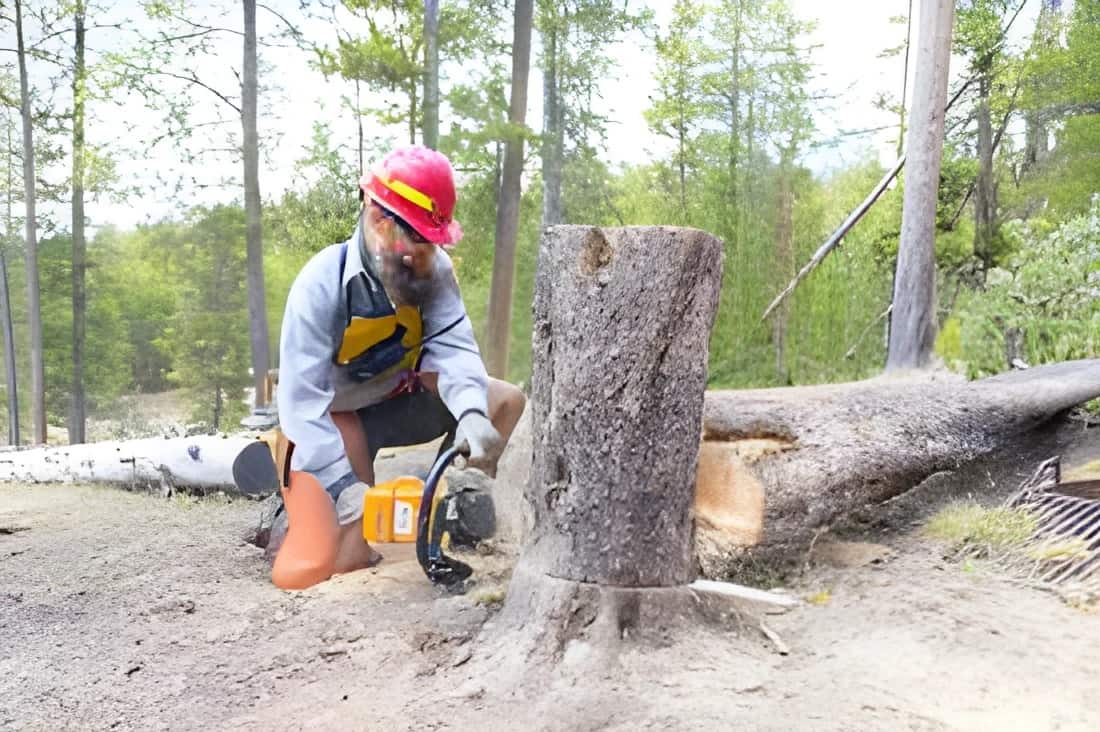Trees are valuable assets to any property, providing shade, beauty, and environmental benefits. However, there are situations when tree removal becomes necessary for safety and property protection.
This article explores the warning signs that indicate when it’s time to consider tree removal rather than preservation.
What is Tree Removal?
Tree removal is the process of completely eliminating a tree from a property, including its trunk, branches, and sometimes the stump and roots.
Unlike pruning or trimming, which aim to maintain a tree’s health and appearance, removal is a permanent solution for trees that pose risks or are beyond saving.
Professional tree removal services use specialized equipment and techniques to safely take down trees, especially those near structures or power lines.
A licensed tree removal company will follow proper procedures to ensure the tree comes down without damaging surrounding property or causing injury.
Tree removal is often considered the last resort in tree care, implemented only when other options like pruning or treatment cannot address the underlying issues.
Before proceeding with removal, many municipalities require a tree removal permit, particularly for certain species or trees of significant size.
Is It Necessary?
The decision between tree maintenance vs. removal is not always clear-cut. Homeowners often struggle with the “save or cut down the tree” dilemma, especially when the tree holds sentimental or aesthetic value. Making long-term tree health decisions requires careful consideration of several factors.
Assessing tree removal should include evaluating both the tree’s condition and its location. A tree too close to house structures presents different concerns than one in an open yard. Similarly, a tree near power lines may require removal even if it’s otherwise healthy.
When considering “should I remove this tree?” homeowners should weigh the risks of keeping old trees against their benefits.
Some trees can be safely maintained with proper care, while others become increasingly hazardous as they age or deteriorate.
Tree removal or pruning decisions should be based on the extent of the problem. Minor issues might be addressed through trimming, while more serious conditions may necessitate complete removal. A proper tree risk assessment helps determine the most appropriate course of action.
Do You Need to Call a Professional?
For most tree removal situations, hiring professionals is strongly recommended. A certified arborist consultation provides expert evaluation of the tree’s condition and the risks involved in either removing or preserving it.
Professional tree evaluation takes into account factors that homeowners might overlook.
Tree inspection services can determine if the tree is truly beyond saving or if alternative treatments might address the problems.
These experts can spot subtle tree removal indicators that aren’t obvious to untrained eyes. Their assessment considers not just the visible symptoms but the tree’s overall structural integrity and health.
When searching for “tree removal service near me,” homeowners should look for companies with proper credentials and insurance.
Emergency tree removal may be necessary in some situations, such as after severe storm damage. The cost of tree removal varies depending on the tree’s size, location, and condition, but it’s an investment in property safety and protection.
Local tree care experts understand the specific challenges and regulations of the area, including permit requirements and environmental considerations.
A professional assessment helps homeowners make informed decisions based on expert knowledge rather than assumptions.
Here Are 6 Warning Signs
A Hollow Tree
A hollow trunk in trees is a serious structural concern that often indicates advanced internal decay. While trees can survive with some hollowness, extensive cavities significantly compromise their stability and strength. Trees with hollow sections are more prone to failure, especially during storms or high winds.
Detecting hollowness often requires professional inspection, as the exterior may appear normal while the interior is substantially compromised.
Tapping the trunk and listening for a hollow sound is one simple test homeowners can perform. Advanced testing methods used by arborists can determine the extent of the hollowing and whether it poses an immediate risk.
When a tree’s hollow section exceeds one-third of the trunk’s diameter, removal is often recommended. At this point, the tree’s structural integrity is severely compromised, making it a hazardous tree near homes or other structures.
Signs of Decay or Damage
Tree decay symptoms manifest in various ways, from visible fungal growth to bark abnormalities.
Cracks in tree trunk surfaces, particularly large or lengthening ones, indicate structural weakness that could lead to failure.
Tree bark falling off in large sections reveals underlying health issues that may have progressed beyond treatment.
A leaning tree risk increases when the lean appears suddenly or worsens over time. While some trees naturally grow at angles, new or progressive leaning suggests root failure or structural problems.
Tree uprooting signs include raised soil near the base, exposed roots, or unusual tree movement in light winds.
Storm-damaged trees often show visible injuries like split trunks, broken major limbs, or partial uprooting.
These damages compromise the tree’s structure and may create entry points for diseases and pests. When a tree is too dangerous to keep due to extensive damage, prompt removal is the safest option.
Dead tree branches throughout the canopy, rather than just in isolated sections, indicate significant health problems.
When more than 50% of a tree’s branches are dead, the tree is unlikely to recover and may require removal.
Fungal Disease
Fungal growth on trees often indicates internal decay that isn’t visible from the outside. Mushrooms or conks growing from the trunk or around the base suggest that decay organisms have established themselves within the tree’s tissues.
These fungi break down the structural components of the wood, weakening the tree from the inside.
Different fungal species target different parts of the tree, with some affecting the roots and others the trunk or branches.
When fungi appear on multiple areas of the tree or form large fruiting bodies, the internal decay is usually extensive. This widespread fungal presence is among the most reliable tree removal indicators.
Controlling fungal diseases is difficult once they’ve become established within a tree’s tissues. While some fungal infections can be managed in the early stages, advanced cases often lead to the conclusion that it’s time to remove a tree to prevent spread to nearby healthy trees.
A Dead Tree
A dead tree poses significant safety risks and should be considered for removal. Signs of a dying tree include tree leaves not growing in the appropriate season, premature leaf drop, or foliage that appears discolored or sparse.
When the entire tree fails to produce leaves during the growing season, it’s likely dead or in severe decline.
Removing unstable trees becomes urgent when they’re completely dead, as they become increasingly brittle and prone to unpredictable failure.
Dead wood lacks the flexibility and strength of living tissue, making dead trees particularly dangerous during storms or high winds.
The risks of keeping old trees increase significantly once they’ve died. While living trees can withstand considerable forces, dead trees have no resilience against environmental stresses.
Tree removal for safety purposes is strongly recommended for dead trees, especially those near structures or high-traffic areas.
Insect Damage
Severe insect infestations can compromise a tree’s health and structural integrity. While many trees can withstand minor pest problems, overwhelming insect populations can weaken or kill even established trees.
Signs of significant insect damage include unusual leaf patterns, visible boring holes in the trunk, sawdust-like material around the base, or a thinning canopy.
Certain insects target specific tree species, and some infestations are more destructive than others. Boring insects that tunnel through the wood can create extensive internal damage that affects the tree’s structural integrity.
When overgrown trees causing damage are also suffering from insect infestations, the combination of stressors may necessitate removal.
Before deciding on removal, homeowners should consult with tree care professionals to determine if the infestation can be controlled. Some insect problems can be treated successfully, particularly if caught early.
However, trees with extensive insect damage throughout the trunk and major branches may not be salvageable.
Rotting Roots
Tree root damage is often difficult to detect until the problem is advanced, making it particularly dangerous.
Signs of root problems include unusual leaning, cracked soil around the base, fungi growing from the soil near the tree, or a general decline in the tree’s health despite adequate care.
Trees affecting underground pipes may show signs of root problems, especially when roots grow around or into utility systems.
These situations create both tree health issues and property damage concerns, often requiring the removal of the tree to prevent further complications.
Trees with significant root rot become increasingly unstable and pose a greater risk of sudden failure. A tree leaning toward building structures represents an immediate hazard that typically warrants removal, especially if root damage is suspected as the cause.
Tree-damaging foundation structures through root growth or pressure present a difficult situation where removal is often necessary to prevent costly structural repairs.
The combination of tree obstruction warning signs and evidence of root problems generally makes the removal decision clearer.
Preventive & Cost Considerations
Being proactive about tree health can sometimes prevent the need for removal. Regular tree assessment and maintenance identify potential issues before they become severe.
Preventing tree hazards through proper care is almost always less expensive than emergency removal after failure.
The tree removal budget varies depending on tree size, location, and complexity. Homeowners should consider obtaining multiple quotes from reputable companies to ensure fair pricing.
Some property insurance policies include tree removal insurance coverage for trees damaged by specific causes like storms, though coverage varies significantly between policies.
Tree removal vs. trimming cost comparisons often reveal that maintenance is more economical in the long run for salvageable trees.
Responsible tree removal decisions consider both current risks and future implications. A tree removal checklist helps ensure all factors are considered before making a final decision.
Affordable tree removal tips include scheduling during the off-season when possible, having multiple trees removed at once if needed, and being clear about expectations regarding stump removal and cleanup. Preparing the site for easy access can also reduce costs in some situations.
When facing tree removal decisions, consulting with tree care professionals provides valuable guidance.
Their expertise helps homeowners make informed choices that balance safety concerns with budget considerations and environmental responsibility.

